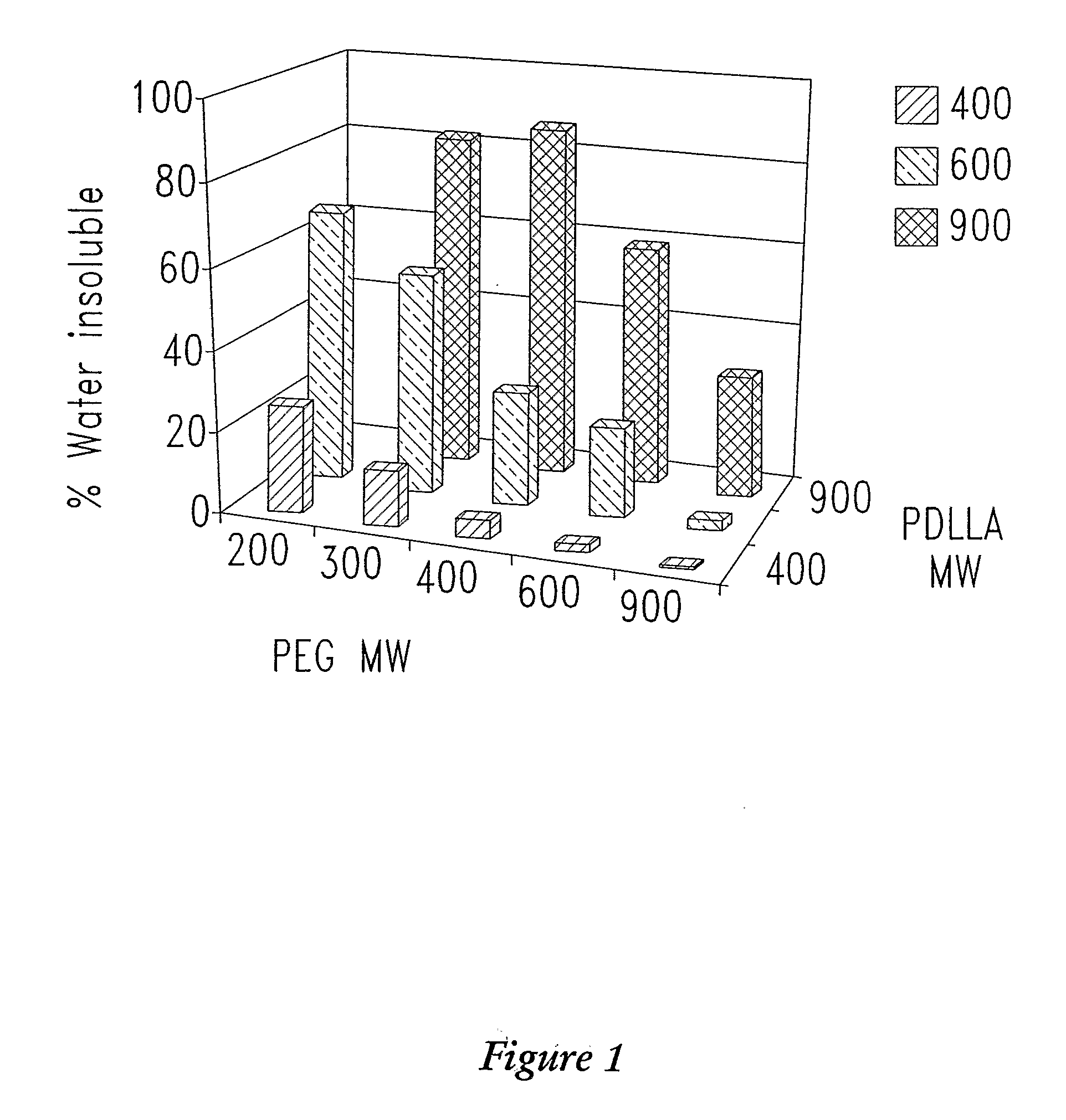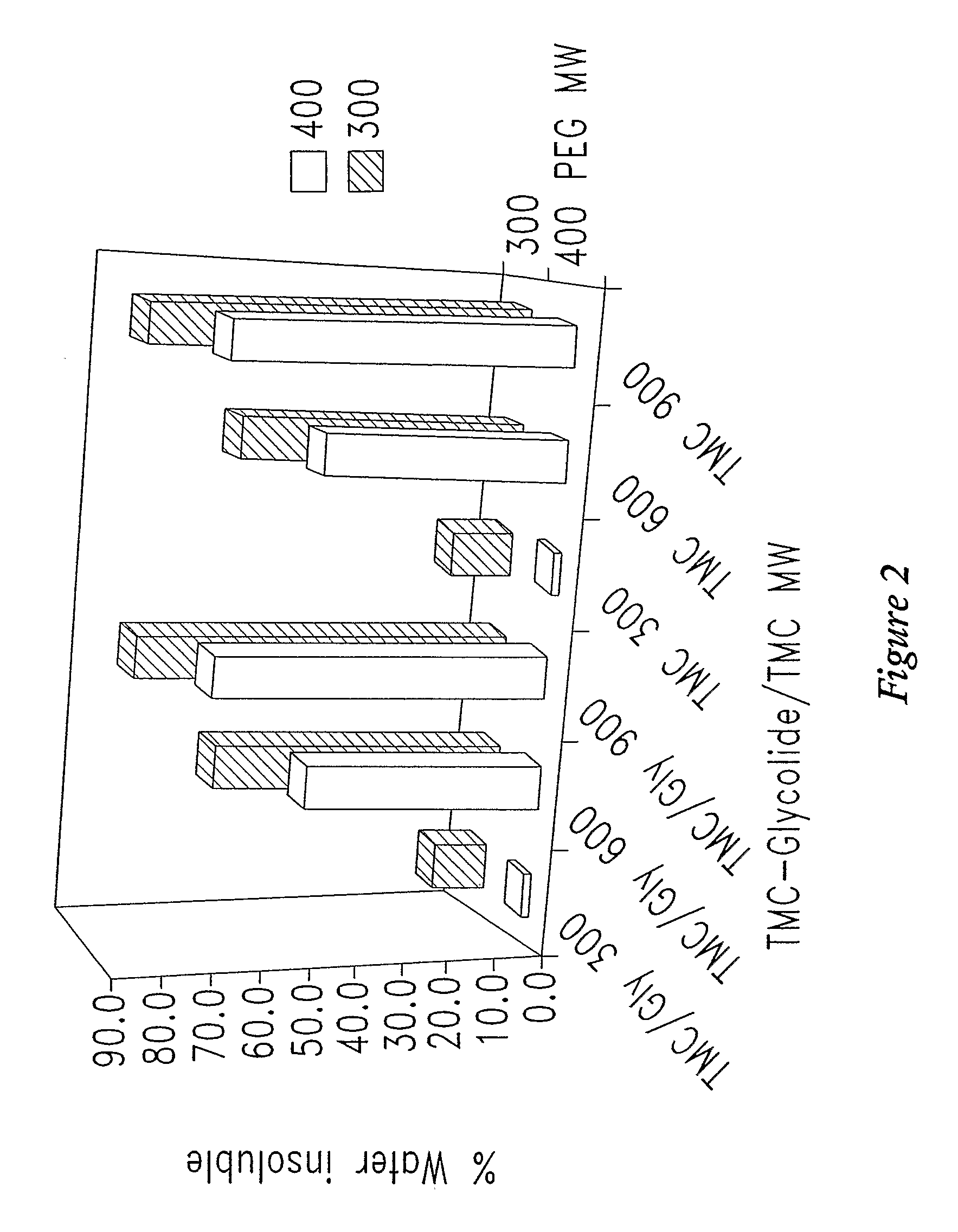Block Copolymer Compositions and Uses Thereof
- Summary
- Abstract
- Description
- Claims
- Application Information
AI Technical Summary
Benefits of technology
Problems solved by technology
Method used
Image
Examples
example 1
Synthesis of Block Copolymers
[0346]PEG and monomer(s) were weighed into 20×150 mm glass test tubes on a top-loading balance and sealed with screw caps. The weights used were weight ratios of their molecular weights. For example, 3.08 g of PEG 400 and 6.92 g of D,L-lactide were used to make 10 g of PEG 400-poly D,L-lactic acid (900). About 400 ml of heavy mineral oil was added into a 2 L beaker and placed on top of a hot plate. The hot plate was connected to a temperature probe which was set at 302° F. (150° C.), with the hot plate set to heat at setting 4 and stir at setting 3. The test tubes were put into the oil bath carefully once the temperature had equilibrated. The test tubes were vortexed after a homogeneous solution was formed and 5 μl / g polymer of stannous 2-ethylhexanoate was added to each tube as a catalyst. The tubes were vortexed and put into the oil bath for 5 hours, during which the tubes were vortexed briefly at 0.5 hours and 1.5 hours. The polymers were poured into ...
example 2
Determination of the Weight Percent of Water Soluble Material in a Polymer
[0348]Empty 50 ml plastic centrifuge tubes were tared and 1 g of polymer was weighed accurately into each tube. 10 ml of deionized water was added to each. The tubes were vortexed, transferred to a 37° C. oven overnight and centrifuged at 2500 rpm for 10 minutes the next morning. The supernatant was removed and discarded to eliminate the water soluble component from the polymer. Another 10 ml of water was added and the above process was repeated. The sample was then frozen in the −20° C. freezer and freeze-dried to completely remove the water. The tube was weighed and the percent mass recovery of the sample and the percent water soluble were calculated.
[0349]In one experiment, of four polymers tested, all were only partially soluble (25 to 40% dissolved) in water (Table 2). The increased proportion of water soluble component coincided with increasing maximum δh values measured in the solubility screening studi...
example 3
Characterization of the “Max δh” Parameter for a Polymer
[0352]The Hansen solubility parameters system was developed by Charles M. Hansen in 1966 for the study of polymer solubility. According to this system, solvents are characterized by three parameters, consisting of a hydrogen bonding component, δh, a polarity component, δp, and a dispersion force component, δd, and all three parameters were related to the total Hildebrand parameter, δt, according to the equation: δt2=δh2+δp2+δd2. This system is described in several texts, for example, Hansen Solubility Parameters: A User's Handbook, Charles M Hansen, CRC Press, 2000. For this characterization, solubility parameters were calculated or obtained from data in this text as well as in Handbook of Solubility Parameters and Other Cohesion Parameters, 2nd edition. Allan FM Barton, CRC Press, 1991.
[0353]Around 20 mg of polymer was accurately weighed into 20 ml scintillation vials and various solvents or co-solvent mixtures were added in a...
PUM
| Property | Measurement | Unit |
|---|---|---|
| Temperature | aaaaa | aaaaa |
| Temperature | aaaaa | aaaaa |
| Temperature | aaaaa | aaaaa |
Abstract
Description
Claims
Application Information
 Login to View More
Login to View More - R&D
- Intellectual Property
- Life Sciences
- Materials
- Tech Scout
- Unparalleled Data Quality
- Higher Quality Content
- 60% Fewer Hallucinations
Browse by: Latest US Patents, China's latest patents, Technical Efficacy Thesaurus, Application Domain, Technology Topic, Popular Technical Reports.
© 2025 PatSnap. All rights reserved.Legal|Privacy policy|Modern Slavery Act Transparency Statement|Sitemap|About US| Contact US: help@patsnap.com



